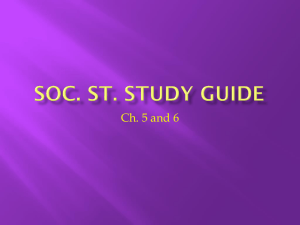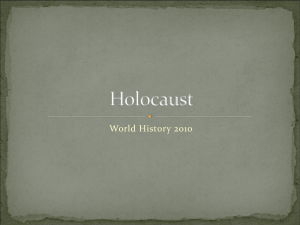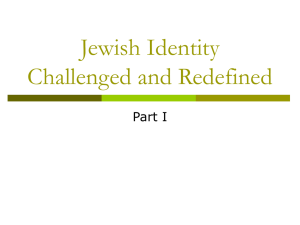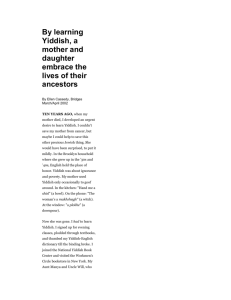View HUMA 6222 Syllabus - Graduate Program in Humanities
advertisement
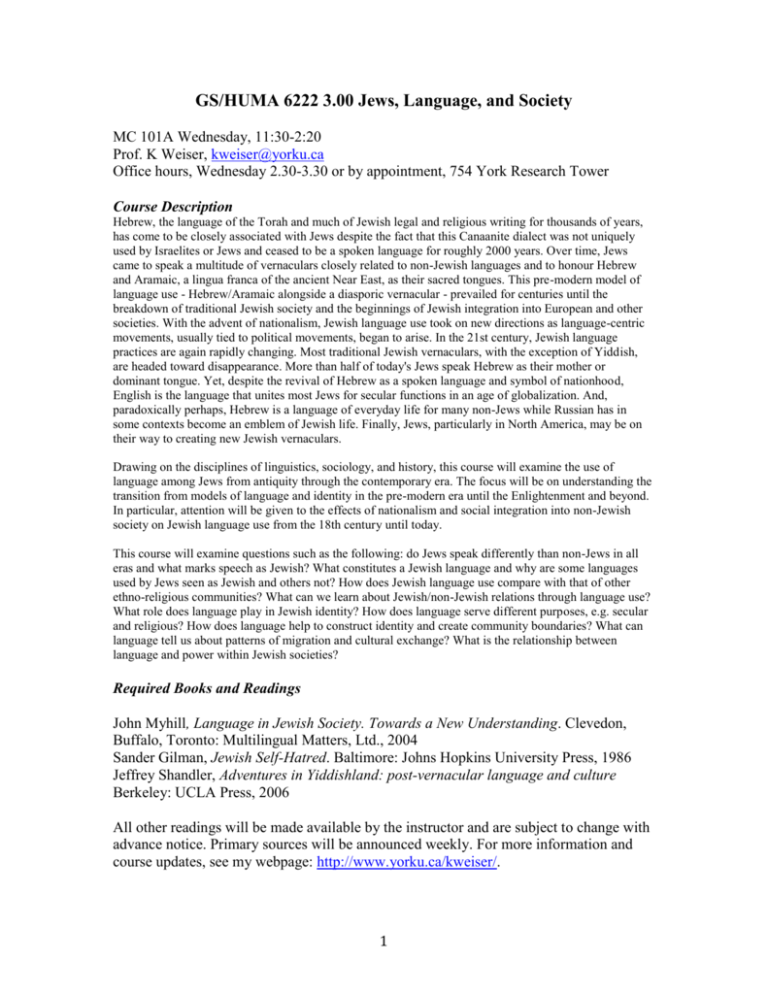
GS/HUMA 6222 3.00 Jews, Language, and Society MC 101A Wednesday, 11:30-2:20 Prof. K Weiser, kweiser@yorku.ca Office hours, Wednesday 2.30-3.30 or by appointment, 754 York Research Tower Course Description Hebrew, the language of the Torah and much of Jewish legal and religious writing for thousands of years, has come to be closely associated with Jews despite the fact that this Canaanite dialect was not uniquely used by Israelites or Jews and ceased to be a spoken language for roughly 2000 years. Over time, Jews came to speak a multitude of vernaculars closely related to non-Jewish languages and to honour Hebrew and Aramaic, a lingua franca of the ancient Near East, as their sacred tongues. This pre-modern model of language use - Hebrew/Aramaic alongside a diasporic vernacular - prevailed for centuries until the breakdown of traditional Jewish society and the beginnings of Jewish integration into European and other societies. With the advent of nationalism, Jewish language use took on new directions as language-centric movements, usually tied to political movements, began to arise. In the 21st century, Jewish language practices are again rapidly changing. Most traditional Jewish vernaculars, with the exception of Yiddish, are headed toward disappearance. More than half of today's Jews speak Hebrew as their mother or dominant tongue. Yet, despite the revival of Hebrew as a spoken language and symbol of nationhood, English is the language that unites most Jews for secular functions in an age of globalization. And, paradoxically perhaps, Hebrew is a language of everyday life for many non-Jews while Russian has in some contexts become an emblem of Jewish life. Finally, Jews, particularly in North America, may be on their way to creating new Jewish vernaculars. Drawing on the disciplines of linguistics, sociology, and history, this course will examine the use of language among Jews from antiquity through the contemporary era. The focus will be on understanding the transition from models of language and identity in the pre-modern era until the Enlightenment and beyond. In particular, attention will be given to the effects of nationalism and social integration into non-Jewish society on Jewish language use from the 18th century until today. This course will examine questions such as the following: do Jews speak differently than non-Jews in all eras and what marks speech as Jewish? What constitutes a Jewish language and why are some languages used by Jews seen as Jewish and others not? How does Jewish language use compare with that of other ethno-religious communities? What can we learn about Jewish/non-Jewish relations through language use? What role does language play in Jewish identity? How does language serve different purposes, e.g. secular and religious? How does language help to construct identity and create community boundaries? What can language tell us about patterns of migration and cultural exchange? What is the relationship between language and power within Jewish societies? Required Books and Readings John Myhill, Language in Jewish Society. Towards a New Understanding. Clevedon, Buffalo, Toronto: Multilingual Matters, Ltd., 2004 Sander Gilman, Jewish Self-Hatred. Baltimore: Johns Hopkins University Press, 1986 Jeffrey Shandler, Adventures in Yiddishland: post-vernacular language and culture Berkeley: UCLA Press, 2006 All other readings will be made available by the instructor and are subject to change with advance notice. Primary sources will be announced weekly. For more information and course updates, see my webpage: http://www.yorku.ca/kweiser/. 1 Recommended Steven Lowenstein, The Jewish Cultural Tapestry. Oxford: Oxford University Press, 2002 Assignments 1. Academic book review comparing two books, 7-10 pages (30%). 2. A research paper treating a theme of this course, 20-30 pages (50%). It is recommended (but not necessary) that this paper build on themes explored by the academic book review. The writing of the paper will be in stages: a) submission of proposed topic and sources (due 21 October); b) outline (due 11 November); c) final paper (due at end of semester) 3. Oral presentation of one’s research in progress (10%). 4. Regular participation in class discussion and introduction of readings (10%). Class Schedule I. Introduction 16 September Jews, language, and communities: an overview John Myhill, Language in Jewish Society, 1-29 Primary sources: R. Akiba Joseph Schlesinger, “An Ultra-Orthodox Position.” The Jew in the Modern World, 202-204 Ehud Banai, “Hebrew Man” Recommended: Steven Lowenstein, The Jewish Cultural Tapestry, 1-48 II. Jews and language in antiquity: Hebrew, Aramaic, Greek, Latin 30 September What is a Jewish language? Chaim Rabin, “What Constitutes a Jewish Language?” International Journal of the Sociology of Language 30 (1981): 19-28 Joshua Fishman. “The Sociology of Jewish Languages from a General Sociolinguistic Point of View,” Readings in the Sociology of Jewish Languages, 3-20 Uzzi Ornan, “Hebrew is not a Jewish Language,” Readings in the Sociology of Jewish Languages, 22-24 Myhill, 29-57 Jews and language in antiquity 2 Max Weinreich, History of the Yiddish Language, “Yiddish in the Framework of Other Jewish Languages,” 45-74 Myhill, 58-69, 109-118 Bernard Spolsky, “Jewish Multilingualism in the First Century: An Essay in Historical Sociolinguistics,” Readings in the Sociology of Jewish Languages, 35-50 Primary Sources: Genesis 10:1-32; Genesis 11:26-32, 12:1-9; Genesis 31:43-50 Deuteronomy 26:5-10 For on an online translation of the Hebrew bible: http://www.mechonmamre.org/p/pt/pt0.htm III. Jews and language in medieval and early modern society 7 October Jewish languages and Diglossia Charles Ferguson, “Diglossia” Word 15 (1959): 325-340 Peter Burke, Languages and Communities in Early Modern Europe, ch.2, “Latin: a Language in Search of a Community,” 43-60 Max Weinreich, History of the Yiddish Language, 74-174, selections Lowenstein, 54-67 David Bunis, “Judeo-Spanish Culture in Medieval and Modern Times,” Sephardic and Mizrahi Jewry, 55-75 14 October Language and Religion. Max Weinreich, “Yiddishkayt and Yiddish. On the Impact of Religion on Language in Ashkenazic Jewry,” Mordecai M. Kaplan Jubilee Volume, 481-514 Max Weinreich, History of the Yiddish Language, 351-4 (merged Hebrew) Myhill, 62-69 Lowenstein, 49-54 Shaul Stampfer, “Heder Study, Knowledge of Torah, and the Maintenance of Social Stratification in Traditional East European Jewish Society,” Studies in Jewish Education, 3 (1988): 271-289 Aya Elyada, “Protestant Scholars and Yiddish Studies in Early Modern Europe,” Past and Present 203 (2009): 69-98 Norman Stillman “Language Patterns in Islamic and Judaic Societies.” Islam and Judaism: 1400 Years of Shared Values, 41-55 IV. The Crisis of Modernity 21 October The breakdown of traditional society and its linguistic impact 3 Sander Gilman, Jewish Self-Hatred, select chapters Lowenstein, 69-83 28 October The Jewish “National Renaissance” and the quest for monolingualism Hebrew and Haskalah Dan Miron, Traveler Disguised, 34-66 Shaul Stampfer, “What did ‘knowing’ Hebrew mean?” Hebrew in Ashkenaz, ed. Lewish Glinert, 129-140 Myhill, 126-140 Primary Sources Haskalah texts TBD Language and Nationalism: Yiddish, Judezmo, Esperanto, Hebrew Yael Chaver, What Must Be Forgotten, 1-44 Yisrael Bartal, “From Traditional Bilingualism to National Monolingualism.” Hebrew in Ashkenaz, 141-149 Norman Berdichevsky, “Zamenhof and Esperanto,” Ariel 64 (1986): 58-71 4 November The Interwar Period: the contested linguistic sphere and language authorities Ezra Mendelsohn, On Modern Jewish Politics, 3-62 Sarah A. Stein, "Asymmetric Fates: Secular Yiddish and Ladino Culture in Comparison," The Jewish Quarterly Review 96: 4 (Fall 2006): 498–509 Todd Endelman, “Assimilation.” YIVO Encyclopedia of Jews in Eastern Europe, 81-87 Benjamin Harshav, “Language. Multilingualism.” The YIVO Encyclopedia of Jews in Eastern Europe, 991-996 Primary Sources: Vladimir Zabotinsky, “Edmée,” 127-139 Ber Borochov, "The Tasks of Yiddish Philology," Science in Context 20:2 (2007): 341– 352. Shlomo (Solomon) Birnbaum, "Jewishness and Yiddish," Irving Howe and Eliezer Greenberg, ed., Voices from the Yiddish, 122-128 Yosef Klauzner, "Ancient Hebrew and Modern Hebrew," Benjamin Harshav, Language in Time of Revolution, 208-215 4 VI. Language use in contemporary Jewish life 11 November Post-World War II: the case of Israel Benjamin Harshav, Language in Time of Revolution, 153-180 Ghilad Zuckermann, “’Abba, why was Professor Higgins trying to teach Eliza to speak like our cleaning lady?’" Mizrahim, Ashkenazim, prescriptivism and the real sounds of the Israeli language.” Australian Journal of Jewish Studies 19 (2005): 210-231 Lewis H Glinert, “Holy land, holy language: a study of an ultraorthodox Jewish ideology.” Language in Society 201 (1991): 59-86 Joshua Fishman, “Language Planning for the ‘Other Jewish Languages’ in Israel.” Language Problems and Language Planning 24/3 (2000): 215-231 Ami Elad-Bouskila, "Arabic and/or Hebrew: The Languages of Arab Writers in Israel." Israeli and Palestinian Identities in History and Literature (1999), 133-158 Primary Sources: Philologos, "Hebrew vs. Israel" http://www.forward.com/articles/4052/ Ghilad Zuckermann, "Let my people know!" http://www.jpost.com/servlet/Satellite?cid=1242212397385&pagename=JPost%2FJPArti cle%2FShowFull Arab Labor 18 November Yiddish and Jewish identity in Anglo-North America Cynthia Ozick, “Envy; or, Yiddish in America” https://www.commentarymagazine.com/articles/envy-or-yiddish-in-america-a-novella/ Jeff Shandler, Adventures in Yiddishland, select chapters 25 November Death and birth of Jewish languages Neil Jacobs, Yiddish: a Linguistic Introduction, “Post-Yiddish Ashkenazic Speech,” 306 Chaim Weiser, Frumspeak, excerpt Sarah Bunin Benor, “Do American Jews Speak a "Jewish Language"?: A Model of Jewish Linguistic Distinctiveness,” Jewish Quarterly Review 99:2 (Spring 2009): 230269 Deborah Tannen, “New York Jewish Conversational Style,” International Journal of the Sociology of Language 30 (1981): 133-149 Anna Verschik, “Jewish Russian and the Field of Ethnolect Study.” Language in Society 36/2 (2007): 213-232 Primary Sources: If these knishes could talk 5 Yona Sabar, “Burying My Mother Tongue” http://www.thejewishweek.com/viewArticle/c228_a15559/Special_Sections/Text_Contex t.html "Rise of Yiddish Scholar Elicits Kvetches From Traditional Yiddishists,” http://www.forward.com/articles/13102/ VII. Summary and Conclusions 2 December Yiddish and Black Vernacular English Max Weinreich, “The Reality of Jewishness Versus the Ghetto Myth: the Sociolinguistic Roots of Yiddish,” To Honor Roman Jacobson. Essays on the Occasion of His Seventieth Birthday, 2199-2211 John R. Rickford, “The Ebonics controversy in my backyard: a sociolinguist’s experiences and reflections” http://web.stanford.edu/~rickford/papers/EbonicsInMyBackyard.html Academic book review paper (7-10 pages double-spaced) Carefully read and study two books on a related topic, making note of the main arguments of the author. Write a review comparing the two works. Be sure to Outline the main argument (or point) of the book and how each author builds up his/her main arguments throughout the chapters. Discuss the authors’ methods (or approaches) and use of evidence to support his or her points. Providing a critical assessment of the strengths and weaknesses of the book. Does the authors achieve what they set out to do? Are their arguments convincing or not, and in what ways? What theoretical assumptions and/or value judgements influence the authors’ arguments? Be sure to provide concrete examples (citing page numbers in parentheses) of the problems or strengths you discuss. (assignment based on Philip Harland’s graduate seminar “Honouring the Gods in the Ancient Mediterranean: A Regional Study of Asia Minor”) Paper proposal and bibliography (2-3 pages double-spaced) Choose a topic relating to the course that interests you. Speak with me to confirm the topic. Write a succinct proposal and outline of the paper, which entails: Stating your topic, its relevance to the course, and the sort of material you expect to cover. Outlining your tentative thesis or main argument and how you expect to structure the paper. Discussing primary and secondary sources that will be useful in research. 6 Providing a bibliography (following an accepted academic style of bibliography correctly). Selected Bibliography of English-language sources Benedict Anderson. Imagine Communities. Reflections on the Origin and Spread of Nationalism. London, New York: Verso, 1991 Jean Baumgarten. Introduction to Old Yiddish Literature. Edited and translated by Jerold C. Frakes. Oxford: Oxford University Press, 2005 Simeon D. Baumel. Sacred Speakers. Language and Culture among the Haredim in Israel. New York: Berghahn Books, 2006 Joan Bratkowsky. Yiddish Linguistics. A Multilingual Bibliography. New York: Garland Pub., 1988. David M. Bunis. Sephardic studies: a research bibliography incorporating Judezmo language, literature and folklore, and historical background. New York: Garland Pub., 1981. David M. Bunis and Andrew Sunshine. Yiddish linguistics: a classified bilingual index to Yiddish serials and collections, 1913-1958. New York: Garland Pub., 1994. Peter Burke, Languages and Communities in Early Modern Europe. Cambridge, New York: Cambridge University Press, 2004. Yael Chaver. What Must Be Forgotten. The Survival of Yiddish in Zionist Palestine. Syracuse: Syracuse University Press, 2004. Peter T. Daniels and William Bright, eds., The World’s Writing Systems. New York: Oxford University Press, 1996. Lucy Dawidowicz. From That Place and Time. A Memoir 1938-1947. New York: Bantam Books, 1989 Aya Elyada. A Goy who speaks Yiddish. Christians and the Jewish Language in Early Modern Germany. Stanford: Stanford University Press, 2012 Gennady Estraikh. Soviet Yiddish. Language Planning and Linguistic Development. Oxford: Clarendon Press, 1999 David E. Fishman, The Rise of Modern Yiddish Culture. Pittsburgh: University of Pittsburgh Press, 2005 Joshua A. Fishman, Ideology, Society & Language. The Odyssey of Nathan Birnbaum. Ann Arbor, MI: Karoma Publishers, 1987 Readings in the Sociology of Jewish Languages. Leiden: Brill, 1985 Jerold C. Frakes, The Politics of Interpretation. Alterity & Ideology in Old Yiddish Studies. Albany: SUNY Press, 1989. Sander Gilman, Jewish Self-Hatred Baltimore: Johns Hopkins University Press, 1986 Lewis Glinert, Hebrew in Ashkenaz. A Language in Exile. Oxford: Oxford University Press, 1993. Tracy Harris. Death of a language: the history of Judeo-Spanish. Newark: University of Delaware Press; London : Associated University Presses, 1994. Benjamin Harshav. The Meaning of Yiddish. Berkeley: UCLA Press, 1990 Language in Time of Revolution. Berkeley: UCLA Press, 1993 Joel M. Hoffman. In the beginning: a short history of the Hebrew language. New York: New York University Press, c2004. 7 Miroslav Hroch, “The Social Interpretation of Linguistic Demands in European National Movements,” EUI Working Paper EUF No.94/1 (1994) Neil G. Jacobs. Yiddish: a Linguistic Introduction. Cambridge: Cambridge University Press, 2005 Dovid Katz. Words on Fire. The Unfinished Story of Yiddish. New York: Basic Books, 2004 John Myhill, Language in Jewish Society. Towards a New Understanding. Clevedon, Buffalo, Toronto: Multilingual Matters, Ltd., 2004 Shmuel Niger. Bilingualism in the History of Jewish Literature. Translated by Joshua A. Fogel. Landham, MD: University Press of America, 1990 Eugenia Prokop-Janiec, Polish-Jewish Literature in the Interwar Years. Translated by Abe Shenitzer. Syracuse: Syracuse University Press, 2003 Angelo Saenz-Badillos, A History of the Hebrew Language. Translated by John Elwolde. Cambridge: Cambridge University Press, 1993 Naomi Seidman, Faithful Renderings. Jewish-Christian Difference and the Politics of Translation. Chicago and London: University of Chicago Press, 2006 Naomi Seidman. A Marriage Made in Heaven: The Sexual Politics of Hebrew and Yiddish. Berkeley: University of Califoria, 1997 Jeffrey Shandler. Adventures in Yiddishland. Postvernacular Language & Culture. Berkeley: UCLA Press, 2006 Bernard Spolsky. The Languages of Jerusalem. Oxford: Oxford University Press, 1993 Bernard Spolsky. The Languages of the Jews. A Sociolinguistic History. Cambridge: Cambridge University Press, 2014 Ilan Stavans. Resurrecting Hebrew. New York : Nextbook: Schocken, 2008. Sarah A. Stein, Making Jews Modern. The Yiddish and Ladino Press in the Russian and Ottoman Empires. Bloomington, IN: Indiana University Press, 2004 Barry Trachtenberg. The Revolutionary Roots of Modern Yiddish, 1903-1917. Syracuse: Syracuse University Press, 2008 Max Weinreich. History of the Yiddish Language. ed. Paul Glasser, trans. Shlomo Noble. New Haven and London: Yale University Press and YIVO Institute for Jewish Research, 2008 Kalman Weiser. Jewish People, Yiddish Nation. Noah Prylucki and the Folkists in Poland. Toronto: University of Toronto Press, 2011 YIVO Encyclopedia of Jews in Eastern Europe. Gershon Hundert, ed. New Haven: Yale University Press and YIVO, 2008 Zion Zohar, ed. Sephardic and Mizrahi Jewry; from the Golden Age of Spain to Modern Times. New York: New York University Press, 2005 NOTE: For extensive references see http://jewish-languages.org and individual articles in Martin Goodman, ed. The Oxford Handbook of Jewish Studies. Oxford: Oxford University Press, 2002 8 Consult also RAMBI on the website of the Jewish National & University Library (www.jnul.huji.ac.il) 9




